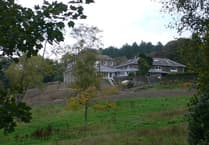An Aberystwyth University graduate returning to Aberystwyth after spending seven years away has shared insight into the art of dog training.
Chelsea Lee first fell in love with Aberystwyth in 2016 when she came to study animal science. It was here that she developed a passion for understanding the behaviour of dogs.
“I loved my time in Aber so much that I stayed for about six years after, until I had to move to Devon to be closer to an elderly relative,” she said.
While away, Chelsea launched Canis Concept, a business offering one-on-one dog training classes. In her own words, the business “completely exploded”.
“I started doing my own in person dog training classes before lockdown, and that worked in my favour because all of a sudden everyone had a dog,” she said.
Chelsea specialises in working with nervous and reactive dogs. She said more dogs than ever are nervous and reactive, because they weren’t able to socialise during lockdown, and weren’t exposed to the everyday situations they would face after lockdown eased.
Dogs that aren’t socialised at the right age embed behaviours and perceptions in themselves about the world, she said. A trainer working with a dog like this has to undo these perceptions in the dog’s mind.
“Dogs embed their behaviours from birth up to about 16 to 18 weeks old, after that, you’re working against their own conditioning,” she said.
“If they haven’t seen anything in that time, it is a lot more scary and unfamiliar to them when they do. It’s more of a struggle for them to process it, and that leads them to more nervous or aggressive behaviour.”
“I had a checklist with my youngest dog, I had the most obscure things on it, so I was taking him on a bus, to see scooters and lorries so that he was familiar with them.”
To embed new behaviours into dogs, dog trainers use a process they call counter conditioning.
“A dog will already have a certain perception of something; typically if they’ve not been acclimatised to it, it will be a fearful response,” Chelsea said.
“What you do is try to undo that perception, you do this by gradually exposing them to the thing that makes them afraid, and make each experience positive for the dog.
“It sounds very simple, but the key is in the execution. It’s about finding that sweet spot where you’re acclimatising the dog, but you’re not overwhelming them. You need to be able to pick up on the subtle signals they give off as they get more nervous, and remove them before their nerves lead them to aggressive or reactive behaviour.”




